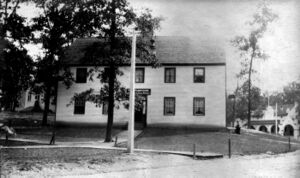New Hampshire
 New Hampshire State Building | |
| Construction Cost | $5,000 (equivalent to $150,796 in 2021) |
|---|---|
New Hampshire's entry was a simple colonial homestead that replicated Daniel Webster's (the American statesman), birthplace. It stood next to the Vermont building, on the Plateau of States.
Etymology
Before the Fair
Description
The quaint structure was striking in appearance, with a high-pitched roof and an absence of eaves, small-paned, old-fashioned windows, and weather boarded sides, and an enormous chimney rising from the center of the roof, exactly like the original at Franklin, N.H.
The interior showcased many early American history artifacts, some a hundred years old. Every room was a wealth of old-fashioned furniture from New Hampshire homes, as well as Webster's relics, davenports, massive polished-top mahogany tables and sideboards, warming pans, antique sideboards, china closets, straight-backed armchairs, grandfather clocks, china and pewter ware. The greater part of the antique furnishings were from the very valuable collection of Gen. William E. Spalding, of Nashua. The state building was provided with a lecture hall for stereopticon lectures, having a screen 16 feet square.
The most elaborate of New Hampshire's exhibits was that of the largest cotton mills in the world, in the Palace of Manufactures, although the state was represented by individual exhibitors in the various exhibition buildings.
After the Fair
The building was supposedly relocated to St. Louis after the Fair and used as a residence.
